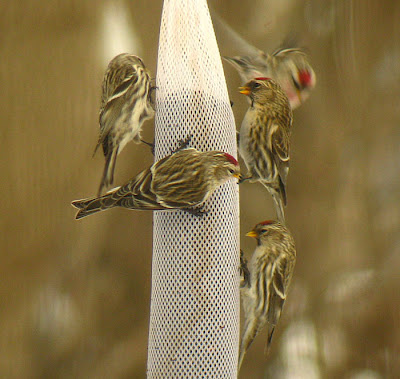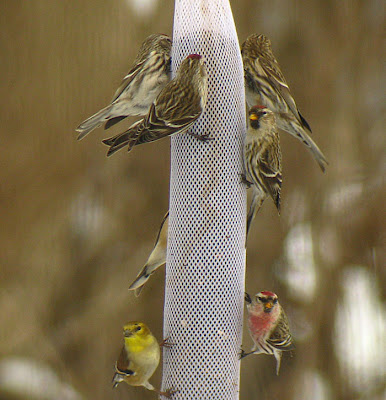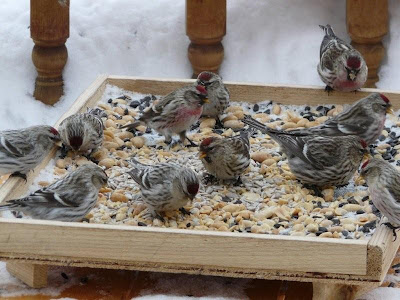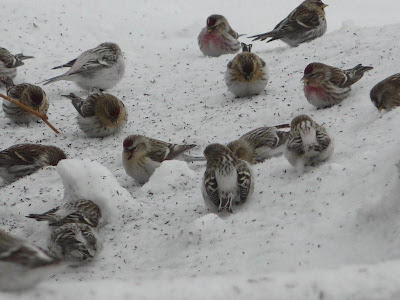Maybe I should change the name of this blog to “All about Redpolls”, but I’ve received a few photos that I wanted to pass along, making the point that “Greater” Common Redpoll is not just an eastern specialty. The AOU checklist and the BNA account report that this subspecies winters regularly from Labrador west to Manitoba, and has been recorded from Michigan, Illinois, Indiana, and Ohio, as well as Colorado!
So here are two photos from Seth Cutright of Ozaukee County, Wisconsin showing an apparent “Greater” (on the upper right). Notice the slightly larger size, larger bill, dark color, and heavy streaking especially on the nape, flanks, and throat. If this is really a “Greater”, it would apparently be the first for Wisconsin, although that may not be too surprising considering the distribution of other records.
And (below) here it is again on the top right, turning away but showing the large size, heavy flank streaking and dark undertail coverts.
Cathy Mountain of Fort McMurray, Alberta also sent me a series of photos from her feeder, and among them is another apparent “Greater” Common Redpoll (far right). The large size, dark color, and heavy streaking is pretty obvious. This would apparently represent a first for Alberta, but that should not be too surprising if the subspecies really winters regularly in Manitoba.
So I would urge anyone who sees Common Redpolls to watch for larger birds and try to document potential “Greater” redpolls. This subspecies appears to wander widely to the west of its breeding range, and could seemingly turn up anywhere within the winter range of Common Redpoll (at least west to the Rocky Mountains).
Another note on Hoary:
Trained observers will notice that the photo above shows several Hoaries. In fact it was Cathy Mountain’s photos from Alberta that prompted me to check CBC results for my post about winter range of Hoary Redpoll. Fort McMurray is obviously within the core of the winter range of Hoary, as the following photo shows.
I guess there are at least eleven Hoary Redpolls in this picture! (when I said “ten” yesterday that was just an error in addition). The seven in the foreground and one back left are so white they are pretty unambiguous – the kind of Hoaries that are seen only rarely east of the Northern Plains region. (I’m also counting the two central birds with tawny head and faint flank streaking as Hoary, as well as the partial bird visible at the top left.)
Notes:
More of Seth Cutright’s redpoll photos
Greg Sargeant reports that there is a “Greater” Common Redpoll in Rhode Island, photo here, which may be the first ever noticed in that state.






Those Alberta Hoaries are very whitish/pale. Could they be hornemanni and not exilipes, despite their range making the latter more likely?
We all love hearing, no I mean learning about these Redpoll! You are teaching us many things that we never would have thought about existed with these species.
Hi Jochen,
I was also struck by the paleness of these birds, but I’m sure they are regular exilipes Hoary Redpolls because they don’t look larger than the Commons. Nearly unstreaked exilipes Hoaries are regular in Alaska, so I think the only reliable field mark for Hornemann’s is going to be size. That doesn’t mean Hornemann’s couldn’t occur in Alberta, but if it does it’s probably very rare there, and the first record would have to be an obviously large individual.
For me, these Alberta photos raise some interesting questions about the birds we have been calling exilipes Hoaries in the east this winter. At least eight of the eleven birds in this photo are obvious and are the kind of definite Hoary Redpoll I’ve searched for this winter. But I’ve only seen a couple in Massachusetts and New York. At the same time I’ve seen about ten pale birds that I felt pretty good about calling “darker Hoary”. So why are such a large proportion of the Hoary-types in the northeastern states ambiguous intermediate birds that we can only identify by careful study, when in Alberta they can get a whole flock of obvious unambiguous pale Hoaries?
Maybe there are lots of ambiguous birds in Alberta and they just weren’t in this photo. Maybe (as in juncos and some other species) the immature females migrate farthest, so the population in New England is skewed toward the darkest age class. Maybe we’re just trying too hard in New England and the few sort-of-pale birds we see are actually hybrids or intermediates and not real Hoaries. I don’t know.
Hi David,
interesting news (to me) about the Alaska exilipes being that pale.
One of the major obstacles on our way to understanding Redpoll variation and species limits seems to be (just as it is the case for a few other species of the high Arctic) that most studies are conducted in the more easily accessable wintering grounds on birds of unproven geographic origin instead of the breeding grounds.
But if we can’t say for sure where certain birds come from and how different looking birds in a winter flock are related to each other during the breeding season, we just cannot distinguish between individual and geographic variation or establish field marks to recognize hybridisation.
Until then, all interpretation of winter flock variation and hybridisation/species limits will possibly be a bit like “educated guessing”.
But it’ll always and invariably be great fun!
Well yes, studying redpolls only in winter, when they are all mixed together, is like studying Thayer’s/Iceland Gulls in winter, and can be a frustrating process. But I enjoy speculation and I’ve learned a lot about redpolls this winter. At the very least we can define some of the variation and formulate questions, which can then help give some direction to the observers who are lucky enough to see these birds on the breeding grounds.
This is all quite interesting and I too have wondered what more studies in the high arctic would reveal to further our understanding of redpoll id. That said, I’ve stuck pretty much to local patches and have had a blast trying to speculate (using great sources such as this site) on useful id criteria. Not sure this is worth much, but it certainly helped pick out Greater Redpolls (rostrata) amongst a flock of ground-feeding redpolls: the Greaters looked like real bullies and noticeably forced smaller birds from their path. I’ve posted some video that displays this here: http://gallery.mac.com/mattpgarvey#gallery. Same size birds seem to bully others too so I’m in no ways suggesting it as a dispositive id trait or anything, but since the Greaters I saw seemed particularly adept at clearing a path for themselves, this helped me pick them out amongst their flocks.
Hello David Sibley,
I am a huge fan of your books and your blog. I have been trying to contact to for a year now. I am 11 years old and my blog is http://birdman-nature.blogspot.com
Goodbye,
Birdman
Hi Birdman,
Thanks for posting here. I’m glad you like my books, and even more glad that you like birds and birding. Keep it up!